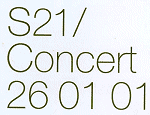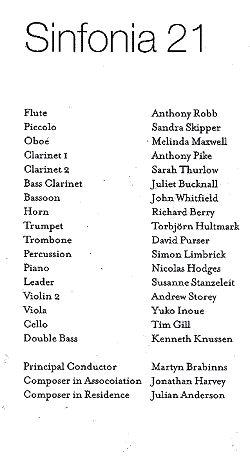
A difficult event to evaluate dispassionately! Half way through Martyn
Brabbins gave us a cheering warm-up chat, much needed because we were
all shivering in the Great Hall of this College of Science & Technology.
He wittily explained that the boiler had broken - it was a Friday evening
so nothing could be done and presumably no one knew how to switch off the
air conditioning, which went about its work of regfrigeration with a will
(outside it was deluging and near freezing; not far away Luton Airport was
closed because of snow!). School students would have been sent home, but
High Art must go on!
Brabbins went on to describe also how his efforts to present Richard Causton's radical arrangement of the Sanctus from the Messe de nostre Dame, with two instrumental groups separated as far as possible, had foundered. A burly, tattooed Fire Officer broke up the rehearsal precipitately, 'don't you know this is a Fire Exit?' - Brabbins & S21 did not have the temerity to reply 'don't you know this is a rehearsal?' and quietly dispersed.

Sinfonia 21, which boasts a line-up of leading free-lance specialists
(including the ubiquitous percussionist Simon Limbrick, several faces familiar
in London Sinfonietta & pianist Nicolas Hodges) has been resident at
Imperial College since 1997, but this was the first time I had heard them
in the comfortable, modern, visually magnificent Great Hall, which proved
acoustically excellent, if a little dry. A valuable concert venue in Kensington,
just south of the Royal Albert Hall. The audience was modest, maybe because
of an unfortunate clash - Birtwistle's Last Supper at QEH.
There were other difficulties, some of which seem to be endemic to contemporary music concerts. Trendy lighting control and programme design is nearly always misconceived. We were told about the usual programme order changes, but it was too dark to check these against our programmes (tasteful light green print), so some guesswork was needed to be sure which piece was being played (not too hard, as the composers were so different from each other). The reverse lighting procedure was incomprehensible; we could dimly discern the text whilst the music was being played; in the long gaps for elaborate platform rearrangements between items, we were plunged into total darkness and left with nothing to do but to admire the swift furniture movers and adept electricians performing their roles balletically. An unscheduled interval was introduced between the two Abrahamsen items, during which we made sorties to seek somewhere not quite so cold; no luck!
To the music! ClaudeVivier (b.1948, murdered in 1983) is a cult figure who gets revived occasionally, and the Government of Quebec was amongst the sponsors. He was a minimalist with melodic inspiration at the centre of his compositions (the S21 Composer in Residence, Julian Anderson, quoted Harry Halbreich, who found in Vivier 'a truly new simplicity' characterised by novelty of timbre). His Trois airs pour un opera imaginaire had Eileen Hulse 'first among equals' in a lush 'solemn unison - - in Vivier's grandest hieratic style' - she was practically inaudible except when the shared line soared into the higher register. The other instrumental work, 'Vivier's most extreme piece', played at the end when we were all numbed with cold, seemed interminable, with five unison movements most of which eventually reached home with a portentous gong stroke - we had to wait during its long decay before the next one could be begun. A trumpet dominated the line much of the time and the other players kept up under Martyn Brabbins' guidance, which ensured excellent playing through the evening despite all.
Richard Causton's way with Machaut was radical and enlivening, the scoring of the Kyrie muscular and forthright, the Sanctus remote and serene. They would sound well in a resonant ecclesiastical setting. Machaut remains endlessly fascinating to contemporary composers, and we were told that his inventiveness derived from de Vitry's discoveries how to notate complex rhythms. Causton succeeded in his aim 'to retain the things which make the piece so extraordinary'.
S21's revival of important scores by Hans Abrahamsen (b.1952) redeemed the evening. A leading younger Danish composer in the 70s & 80s, and a regular visitor to London for performances of his music, he had been 'silent' for a decade, but now there is a new piano concerto. Marchenbilder needs to be heard more than once and, to sort it out, a glance at the programme would have helped - six Fairytale Pictures in three movements - dazzling, eventful music, teeming with instrumental felicities. The four movements of Winternacht are cast in Abrahamsen's typically dense texture, contrapuntal and hocketing (links to Machaut), built by superimposing increasingly complex individual lines. The opportunity to hear these works made the journey (just) worthwhile. (In the old days, a programme like this would have been one of the BBC Radio 3 College Concerts - I hope Sinfonia 21 will have an opportunity to broadcast and record at least some of this programme.) Better luck to S21 next month!
Peter Grahame Woolf
The next Sinfonia 21 concert at Imperial College, to be conducted again by Martyn Brabbins, will be on 9 February, to include Copland's Short Symphony, Beethoven's 8th, and a new work by Julian Anderson (details from : info@sinfonia21.co.uk
 Return to:
Return to: